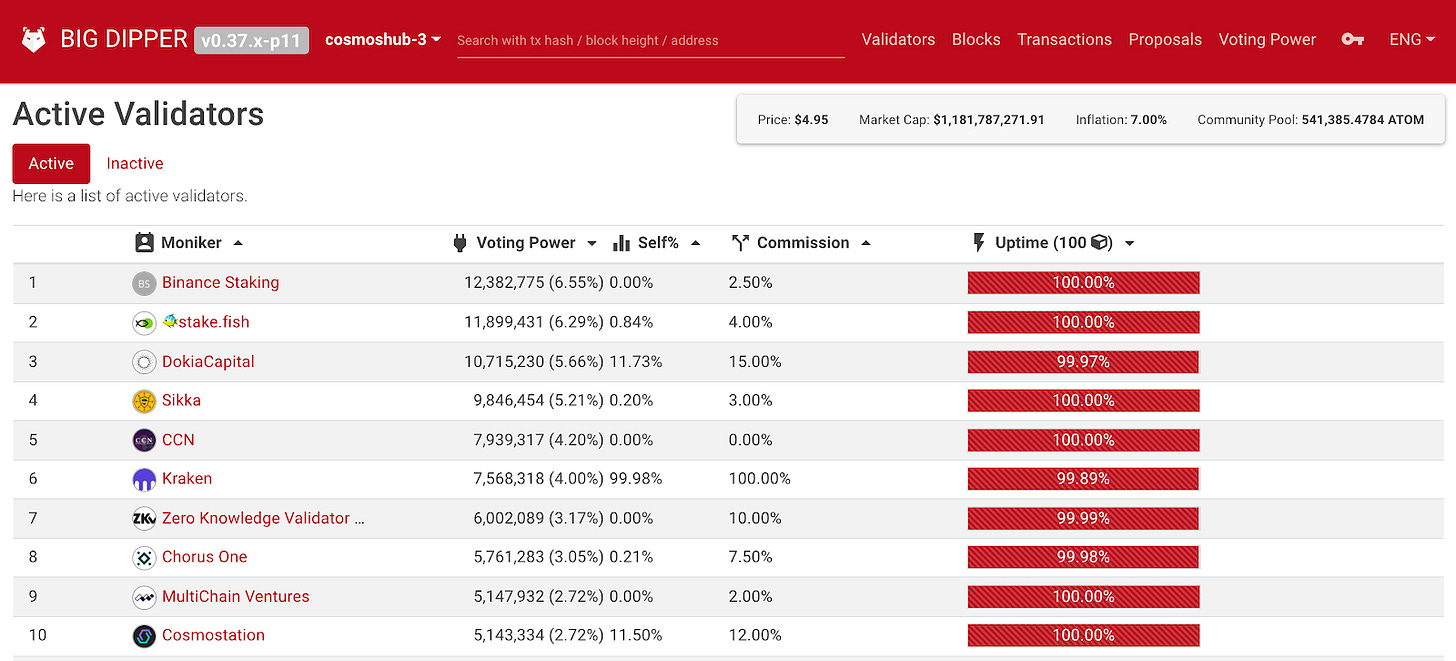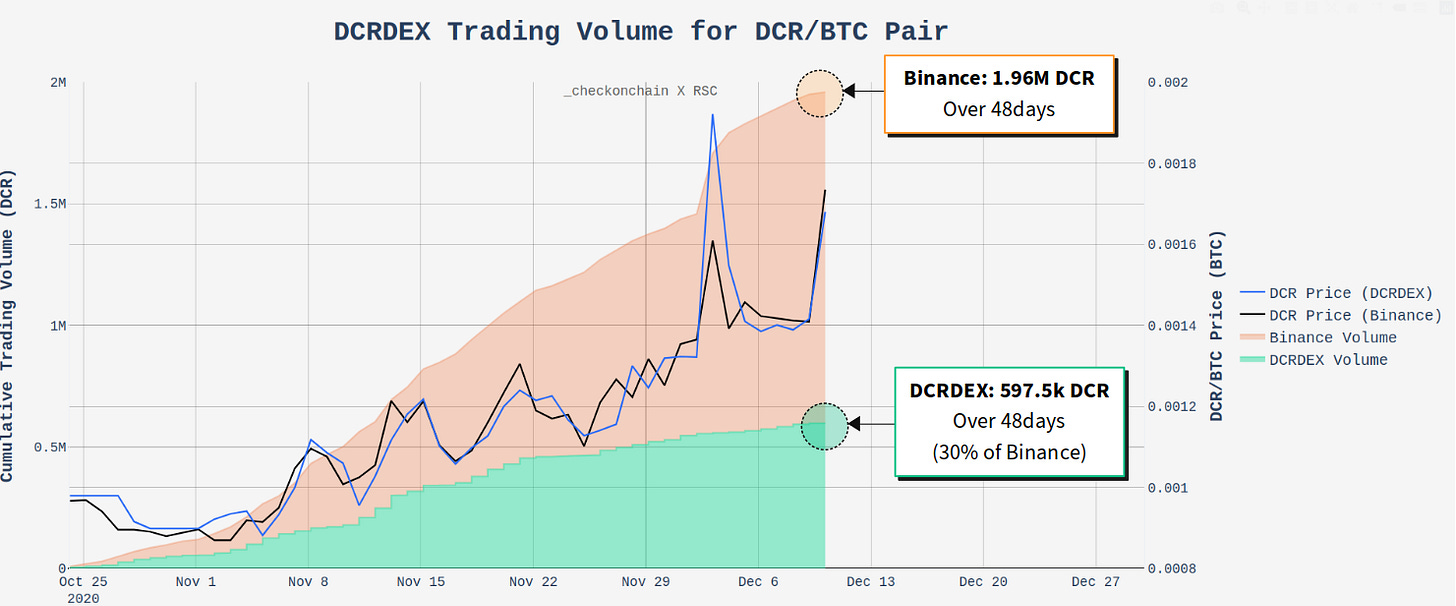Our Network: Issue #50 (Part 2)
Coverage on Ethereum, Bitcoin, Cosmos, and Decred.
Continued from Part 1.
Despite a constant flow of new wallets created with non-zero balances, the vast majority of them are being created on centralized exchanges. 17,217 new wallets were made between Oct 9 and Dec 8, 2020. 40% of all accounts created in the past 6 months were done on Binance. And between Binance and Coinbase, the two largest ATOM onramps, that’s 65.5% of all new accounts created. This tells us that the demographic of most new stakers are composed of speculators, not developers or project enthusiasts; if it were the latter, then new account generation would start at the non-custodial wallet level, which is not at all what the data reflects.
With the majority of new accounts being created on exchanges, which, by the way, offer staking directly on their exchanges, those CEXs have become the largest validators in the Cosmos Hub. Binance is now the #1 validator on the Cosmos Hub by stake-weighted voting power. Binance itself puts up 0% of that voting power with its own ATOMs, which opens up misaligned incentives for Cosmos Hub.
When a validator puts none of its own ATOM at stake, in theory, it has no skin in the game. Which means that if Binance Staking validator ever gets slashed, then the entire cost of the penalty is incurred by its stakers, not by Binance. So we’re seeing a small but existential crisis unfolding now which has implications for all PoS networks. PoS networks rely on properly incentivized validators (i.e. consensus nodes) to do their parts in progressing the chain or performing software upgrades, with the emergence of exchange-operated validators, who have shown to be “lazy stakers”, these exchanges aren’t actually participating in testnets or possibly even chain upgrades altogether. We observed this over the Stargate testnet, which is the IBC testnet that’s being used to battle-test IBC before being launched into production.
Stargate testnet failed to reach quorum 4 times with using its existing set of mainnet validators. This meant that the testnet failed to even start due to low validator participation. The largest one, Binance, didn’t even show up to the party. This is a huge DOS vector for PoS blockchains. If we can predict that most new stakers are going to be speculators and that speculators are low-information stakers, then they’ll tend to default to leaving their stake on exchanges. And if we know that exchanges are indeed lazy stakers themselves, then this poses a potential risk to all PoS chains when exchange validators inevitably become the biggest validators in those networks.
The cycle of wallet generation happening on exchanges gets recycled back to the exchange when delegators unbond. We see in the data that ATOMs get sent right back to Binance when someone unbonds. This means that (a) delegators have no incentives to keep their liquidity locked into ATOMs once they’ve maximized on their staking returns, and (b) that the most profit-maximizing thing they could do with ATOMs is to sell it back in the secondary market when ATOMs grow in value. This can be a thesis as to why PoS networks should (and must) establish its native staking token as the settlement layer to all things second layer borrowing, lending, derivatives, synthetics, and DeFi-related in order to keep liquidity solidly in its network. When the returns from collateralizing the staking token to earn yield from DeFi activity exceed the returns from simply trading the underlying staking token, then these networks may, counterintuitively, see greater stability of its network staking target. For Cosmos Hub, that target has gone down somewhat over time as ATOM grew in value rather than gone up.
④ Decred
Contributor: Checkmatey, On-Chain Researcher for Decred
The Decred network has experienced a non-trivial increase in network activity and transaction volumes during Q4-2020, with a number of on-chain metrics hitting all time highs.
In mid-November, Decred’s price finally overcame a key psychological resistance level in the Realised Price. Supporting this break, on-chain transaction volume increased to an average of over 1.0M DCR moving on-chain daily. This activity is leading the Realised Price to trend strongly higher and on the 3-Dec, a new all-time-high of 5.16M DCR was settled on-chain (~40% of circulating supply!).
Decred has a major consensus change vote upcoming which, if approved on-chain, will hand over all Treasury spend transactions from a multi-sig, to a formal DCR stakeholder vote. This protocol upgrade has been under development for a number of years and is a greatly anticipated a transition to full stack DAO.
In the lead up to this consensus vote, the total supply of DCR staked in tickets has reached a new All Time High (ATH) of 54.13%, equivalent to 6.674M DCR. The Ticket Price also hit two consecutive ATHs first at 188.59 and then at 190.64 DCR 11 days later (ATH considered after the stake-diff algo change).
Decred is in the process of releasing a significant wallet GUI upgrade which supports the CoinShuffle++ Privacy mixing implementation. Over the past month, wallet release clients have been tested by the community with a corresponding boost to the daily volume flowing through the CoinShuffle++ mixer.
On 28 November, daily mixed volume reached a new ATH of 272.6k DCR, at the time equivalent to $5.94M in value. The 30-day average daily mix volume has increased 50% from the long term average of ~100k to over 150k DCR per day. Since August 2019, a total volume of 45.6M DCR has been anonymised (over 3.7x circulating supply!).
Decred recently released the MVP implementation of DCRDEX, a decentralised exchange that utilises atomic swap technology. A DCRDEX server may be hosted by any entity, each with full and permissionless autonomy over which market pairs they list.
The DCRDEX server that is hosted by the Decred project has been publicly live with a DCR/BTC pair for 48-days. To date, a total of 597.5k DCR has been traded, representing 30% of the equivalent volume on Binance. Price on the DEX has also maintained close parity with that trading on centralised exchanges.
Finally, Decred's implementation of the Lightning Network is now live and operational on Mainnet. The GUI is built into release client wallets and is in the early stages of live experimentation by the community.
In the first month, the Decred Lightning Network has established 26 Nodes, 47 Channels and supports a total capacity of 11.58DCR. We are still in early days but it is certainly an exciting step towards seeing the Lightning Network grow on Decred.









